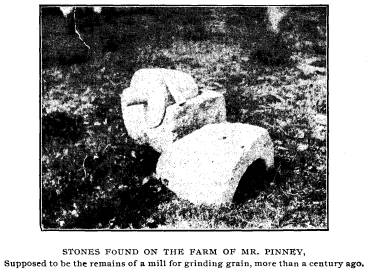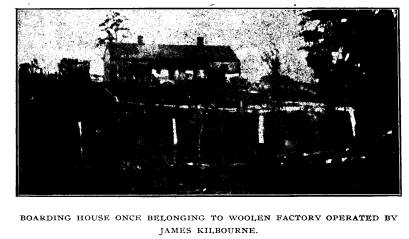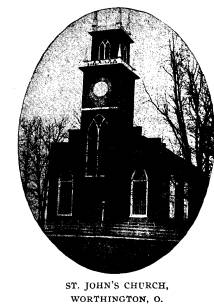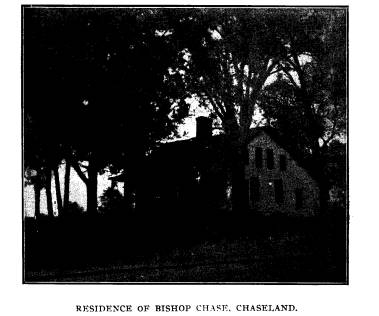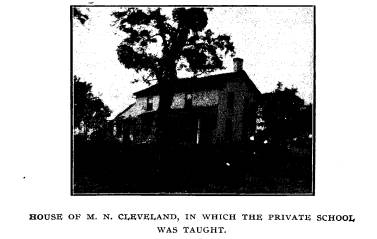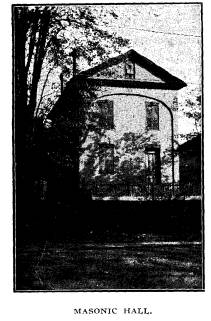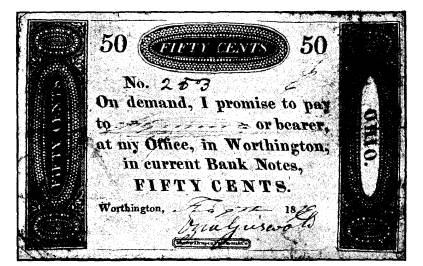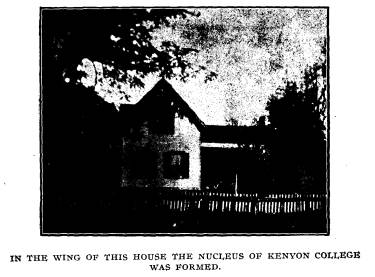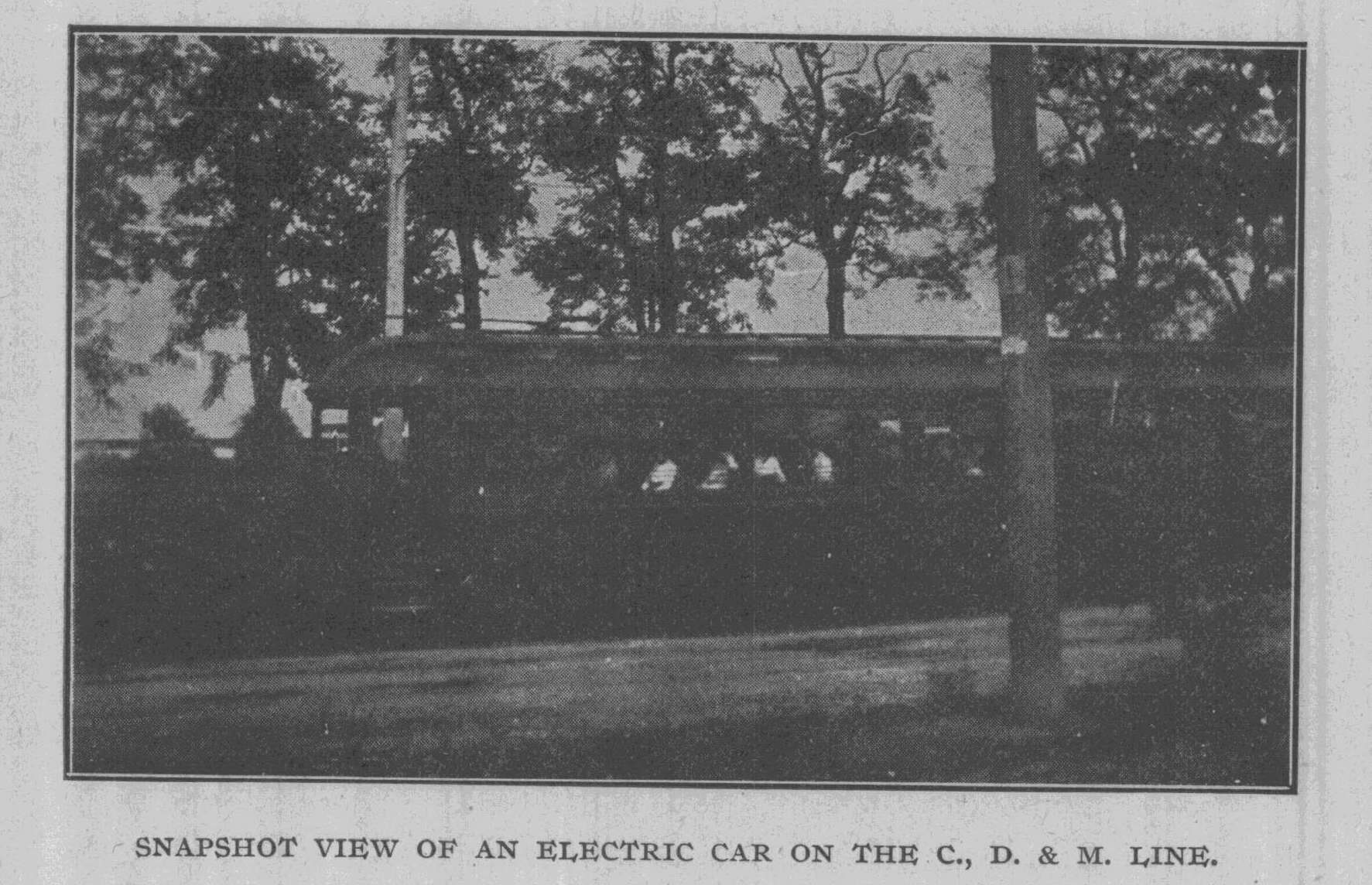Ohio History Journal
HISTORIC
WORTHINGTON.
MIRA CLARKE PARSONS.
One hundred years ago, in the month of
October, the quiet
of the wilderness where Worthington now
stands, was broken
by the arrival of forty families, under
the leadership of James
Kilbourne. The journey had occupied more
than six weeks.
They came from Granby and Simsbury,
Conn., representing
many trades and occupations, and
bringing the hope and courage
needed in founding a new home in a
strange land.
The previous year their leader and
Nathan W. Little, as
agents appointed by the Scioto Company
to explore the territory
of the United States northwest of the
Ohio river, had gone
through the country between Chillicothe
and this place, and de-
cided to locate their colony here.
From a record kept by Mr. Kilbourne, we
find that the two
men traveled by stage from Granby to
Shippenburg, Pa. Thence
carrying packs, they walked over the
mountains to Pittsburg,
one hundred and fifty miles, thence to
Wheeling, and on through
Ohio.
A description of the land and its
products reads like a chap-
ter from the Book of Numbers, when Caleb
and Joshua brought
to the waiting Israelites their report
of the land flowing with
milk and honey. Mr. Kilbourne says:
"We found Black Walnut, Hickory,
Ash, Honey Locust,
Hackberry, Whitewood, etc., which never
grow on any but first
rate land." He described the rivers
as "clear, lively streams of
pure water as ever flowed from a
fountain." He tells us:
"In one place I saw a thousand
acres of the best clear meadow
I ever saw in any place whatever."
He says: "Plums and
crabapples are the principal fruits, of
which there are thousands
of bushels to be found in any part of
the country, and the plums
are very palatable fruit." There
were also large quantities of
grape vines.
(71)
|
72 Ohio Arch. and Hist. Society Publications.
The giant which possessed this goodly land, "making it sickly to a considerable degree," was the fever, which lurked in the rich acres lying on the banks of the streams, where it waited to make war upon the settlers living on these low bottom lands for greater convenience to water supplies. He quotes Col. Worthington,* Register of the United States Land Office at Chillicothe, "a gentleman of first rate informa- tion," as saying that he believed that the country would be as healthy as any country whatever, when opened and improved. |
|
|
|
And so it came to pass, for, as of old, "by little and little, the enemy was subdued." The Scioto Company, formed in the winter of 1801-2, orig- inally consisted of eight families, the number being afterwards increased to forty. They delayed purchasing the land, until sure that the new State constitution about to be formed, would pro- hibit slavery. Then, 16,000 acres were bought at $1.25 per acre, -8,000 in Sharon township, and 4,000 each in Clinton and Del- aware townships. When the town was laid out, each man was entitled to a town lot of 3/4 of an acre, and a farm-lot of 983/4 acres. *From whom the town was afterwards named. |
|
Historic Worthington. 73
The advance guard of this band of pioneers came to Ohio in the spring or early summer of 1803. It consisted of Samuel Kilbourne and family, Levi Pinney, Alexander Morrison, Adna Bristol, Edward Brown, and Israel P. Case. They were sent to build cabins for the colony. The remainder started on Septem- ber 15th. Mr. Ezra Griswold arrived first with his family, but by the last of October the whole company had completed the journey.* The first cabins were built around the public square, and one well supplied the community. The women were restricted |
|
|
|
to bringing the most necessary articles for pioneer housekeeping. It is told by one of their descendants that three neighbors brought a brass kettle, a wooden chair, and a sieve, to be exchanged for mutual convenience, like the eye of the Three Gray Sisters, in *NOTE:-The delay of a part of the company was caused by the arrival of a stranger in James Kilbourne's camp. His daughter Orrel, afterwards the wife of I. N. Whiting, of Columbus, was born in an emi- grant wagon, in Washington County, Pa., October 15, and was the young- est member of the pioneer band. Another daughter, Cynthia, born a few years later, in Worthington, became the wife of Dr. I. G. Jones, of Co- lumbus, and had the honor of being the first mother in Ohio who of- fered her son for service in the Civil War. James Kilbourne Jones was the first man in the State to enlist at the first call of Lincoln for troops. |
|
74 Ohio Arch. and Hist. Society Publications.
Hawthorne's Wonder Books. The partnership was dissolved when the sieve gave out. The first Christmas dinner found wild turkey and venison upon their tables, and maple sugar, obtained from the sap of the wild forest trees around their new homes. The climate was much milder than now, and snow was rarely seen. Before leaving New England, articles had been signed by the company, providing for the appropriation of town lots for an Episcopal church and an Academy at the time when each man's |
|
|
portion should be assigned. The first tree felled for building purposes was used in the erection of a log cabin which served for both church and school house. The build- ing was also to be used as a fort, in time of trouble with the Indians. Within its walls, on February 8, 1804, the first marriage ceremony in the new settlement was performed by Zachariah Stephen, Esq., of Franklin- ton, the nearest Justice of the Peace. It was a double wed- ding, uniting Abner Putnim Pinney and Polly Morrison, and Levi Pinney and Char- lotte Beach, in the holy bonds |
|
of matrimony, amid the rejoicing of assembled neighbors and friends. Previous to the erection of St. John's church in 1830, the oldest Protestant Episcopal church west of the Allegheny moun- tains, services were held in the academy building, as soon as it was built. Elnathan Maynard, who recently died in Cincin- nati, in his ninety-seventh year, was the last survivor of those who assisted in the building of this historic old church. His father, Stephen Maynard, gave the lumber for the pews as they |
|
Historic Worthington. 75
now stand. When in later years, the spire was pronounced un- safe, that part of the church was rebuilt, with great loss to its first architectural beauty. In the old records, the founder of this colony is called "Rev." James Kilbourne, though known in later years as "Colonel." He combined both titles, having taken orders in New England. Together with Mr. Erastus Burr, (the first pupil in the embryo college, and afterwards a Doctor of Divinity,) he conducted church services for a considerable time. |
|
|
|
Philander Chase, "pioneer bishop and educator west of the Alleghany mountains," was rector of St. John's parish from 1817 to 1822. He built the dwelling house now standing in Chaseland, and laid the foundation of Kenyon College in a room which is a part of the house now occupied by Mr. George Cless. He was closely associated with the educational interests of the town. The Methodist Episcopal church was formed in 1811, at a class meeting conducted by Revs. Mitchell and Sabin, in a log |
76 Ohio Arch. and Hist. Society Publications.
cabin on the old factory ground west of
the town. It consisted
at first of eleven members, and the
meetings were held in dif-
ferent dwelling-houses. In 1823 a brick
church was built on
East State street. This was taken down
and the present house
of worship erected on Main street in
1828. Within its walls the
eloquent young preacher, Frank W.
Gunsaulus, won his first
laurels.
The Presbyterian church (Old School) was
organized June
18, 1816, with a membership of sixteen.
Previous to this time,
Ebenezer Washburn of Blendon, had
sometimes preached in pri-
vate houses.
The first settled minister was Rev.
Hiram Hurlburt, who
held services for a time in Masonic
Hall. The present church
edifice was built in 1829. It was
remodeled in 1843.
Worthington Academy was incorporated by
the legislature
of Ohio, February 20, 1808, with
Bishop Chase as president.
Eleven years later, a new charter was
granted, incorporating it as
Worthington College. Bishop Chase soon
resigned the presi-
dency of the new institution, and his
son, Rev. Philander Chase
Jr., took his place.
Col. Kilbourne was largely instrumental
in locating a Re-
formed Medical Institute here. He, with
the other trustees of
the college, offered the use of their
charter and building to Dr.
Beach, the founder of eclecticism, for
his proposed medical school
in the West. It was opened in December
1830, with a fair pros-
pect of success. But by reason of
financial difficulties, and the
strong opposition of enemies, it did not
prosper long. It re-
ceived its death blow in what is still
remembered as the "Resur-
rection War," although it was not
formally closed until three
years later.
The college buildings were taken down in
'73, to make room
for the commodious school edifice which
now occupies the spot.
The old bell still sounds its invitation
for the youth to come and
taste the sweets of learning.
A passing word must be said of the
private school taught
two generations ago by Miss Loiza Topping
in the house now
owned and occupied by Mr. Nathaniel M.
Cleveland. He is the
sole survivor of the children who
constituted this embryo kin-
|
Historic Worthington. 77
dergarten, some of the methods of which were not perhaps strictly Froebellian. Worthington Female Seminary had its beginning in 1838, in Masonic Hall, where Miss Sarepta Marsh of Chillicothe started a school for girls. She, with Revs. Heath and Young, soon ob- tained permission from the Methodist Conference at Xenia, to open a Female Seminary. The funds were raised by the united efforts of these friends of education. Four acres of the land centrally located were bought, and a roomy building erected. |
|
|
|
The school was opened with Miss Marsh as principal, Misses Sarah and Maria Tucker, teachers, and Nancy McGill, assistant tutor. It was highly prosperous for a while as a girls' school, but was unable to compete with the Ohio Wesleyan University at Delaware, after that institution had established co-education. Failing to receive an expected legacy of large amount, its doors were at length closed, to be re-opened for a time as a Normal School, by Messrs Mitchell and Ogden. Since then it has been occupied in turn as a Fresh Air Resort for city children, a sani- tarium, and a summer hotel, till now, in the hands of private individuals, as Worthdale, it holds but a memory of former days. |
|
78 Ohio Arch. and Hist. Society Publications.
The oldest Masonic Institution, after the one in Marietta, is New England Lodge No. 4, at Worthington. It was organized on the 28th day of June, A. D., 1808, A. L. 5808. Royal Arch Chapters: Ho- |
|
|
reb Chapter No. 3 was or- ganized at Worthington, De- cember 18, 1815. Mt. Vernon Encampment No. 1, of Knights Templar and Appendent Orders was instituted at Worthington, March 15, 1818. This was the first dispensation granted by the General Grand En- campment of the United States, first encampment of the Order organized west of the Alleghany mountains. After February 24, 1844, the meetings of the Encampment were held in Columbus by virtue of authority derived from the Grand Encamp- ment of Ohio. Independent Order of Odd |
|
Fellows, Ark Lodge No. 270, was instituted in Worthington, April 16, 1855. Of the seven charter members who first com- posed it, A. S. Wood, the first officer, is the last survivor. The first newspaper in Franklin county was published in Worthington in 1811, by Ezra Griswold. It was called the "Western Intelligencer." Col. Kilbourne was the original pro- prietor, but it soon passed out of his hands. In 1814 the office was removed to Columbus, and the paper conducted by Ezra Gris- wold, Joel Buttles and P. H. Olmstead, took the name of "West- ern Intelligencer and Columbus Gazette." It was the parent of the "Ohio State Journal." The old printing office is still to be seen in Worthington. |
|
Historic Worthington. 79
Mr. Griswold was a private banker, and issued paper money in the form of printed notes of six denominations, varying in value from six and a quarter cents to two dollars. Some of these notes were engraved by a Philadelphia firm, others were printed in Worthington. A gang of counterfeiters broke into the Worthington office one night, and made money at a rapid rate. The first date of any of the bills now found, is 1810, the latest, 1819. The Worthington Manufacturing Company also issued money of this kind, but the high tax, and the ease with which it could be counterfeited, soon brought it into disuse. |
|
|
|
Orange Johnson, who came to the town in 1812, had a factory in his own yard, where he made combs of every de- scription. Some of them, the beautiful, high-backed, tortoise- shell marvels which ornamented the heads of the fore-mothers of Worthington, are still preserved by their descendants, as rare and curious relics. In a brick building on Main street, but recently taken down, Potter Wright and his assistants made carding machines from models of Mr. Wright's own drawing, still preserved, and bear- ing date, "1811." He was a machinist of great ability. He as- |
|
80 Ohio Arch. and Hist. Society Publications. sisted James Russell in the early days, to construct an orrery, the patterns for which were long kept in the old shop. Mr. Russell, accompanied by George H. Topping, a young lad whose father, Dr. Josiah Topping, was the first physician in the colony, - exhibited this machine through the country, from Worthington to Washington. It was finally destroyed by fire, and never duplicated, on account of the expense attending its construction. The chief industries of the growing town, however, were car- ried on in the factory village, situated in the west part, on the |
|
|
|
banks of the Whetstone river now restored to its original name of Olentangy. Here may still be seen the ruins of a building erected by Col. Kilbourne, the first custom grist-mill in the vicinity. The sites of a lime-kiln, a tannery, a hat-shop, and a dis- tillery are all traceable. The "Worthington Manufacturing Company" was incorpo- rated in 1811, with Col. Kilbourne as President. It was the pioneer manufacturing enterprise of Central Ohio, making a great variety of articles. In the war of 1812, it furnished woolen fabrics for army and navy. It failed in 1820, sweeping away the |
|
Historic Worthington. 81 entire
fortune of the President. The boarding house connected with this factory is still standing. There was also a cabinet-makers' establishment which turned out beautiful pieces of furniture made from the native woods. Some of these are treasured in the village, as heirlooms beyond price. The owner of the hat-shop was assisted in winter by Elias Lewis, a young man who followed his trade of brickmason in summer. In later years, when Salmon P. Chase was Governor |
|
|
|
of Ohio, Mr. Lewis was proud to say that the chief
executive had worked for him in the capacity of
hod-carrier. "Uncle Elias," as Mr. Lewis was affectionately called,
was one of the company of emigrants of 1806. Whenever they camped
for the night, he entertained the wayfarers with dancing to
the accom- paniment of a fiddle. After he became a famous
Methodist ex- horter, it is said that in his highest flights of
eloquence, he would unwittingly "cut a pigeon-wing," to the
great edification of his hearers. Vol. XIII-6. |
82 Ohio Arch. and Hist. Society Publications.
For many years he drove the stage on the
old tollgate road
between Worthington and Columbus.
*
* *
When the site for the capitol of the new
State was being
selected, several different locations
were offered. The choice
finally lay between Worthington, and the
yet unnamed and un-
broken territory where Columbus now
stands. Capt. Alfred E.
Lee, in his "History of
Columbus," says:
"Although Worthington was the most
elevated, the healthiest,
and by far the most comely situation, it
was overmatched."
On February 14, 1812, at Zanesville, the temporary meeting-
place of the law-makers of Ohio, the
election was made which
constituted Columbus the future
capital.*
To-day, with the voice of the factories
stilled, the seminary
converted into a dwelling house, the
college a thing of the past,
and the printing press silent, must we
say that this beautiful old
town is asleep?
As in the old fairy tale, Prince
Charming is on his way to
awaken her. He is coming in a new
electric car, and may bring
as a marriage portion to his bride two
gifts of which she is
dreaming,-natural gas, and a complete
system of water works.
With these, who can prophesy what the
future may hold for her?
NOTE:-It is said that the vote which
decided the question was
bought by a glass of whiskey, but this
is not a well authenticated fact.
NOTE :-The writer of this article is
indebted for information to Lee's
History of Columbus; Howe's Historical
Collections of Ohio; Martin's
History of Franklin County; Felter's
History of the Eclectic Medical
Institute of Cincinnati, Ohio; The
"Old Northwest" Genealogical Quar-
terly, and recollections of the
descendants of the pioneers. The illustra-
tions were kindly furnished by Mrs.
Fredonia Case, Frauk Welling, Willis
C. Parsons, and W. F. Griswold, Esq.
